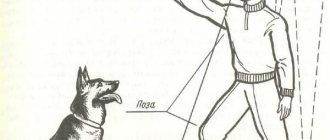So that your puppy can fulfill basic requests, obey, and you can curb his activity, you need to train him from childhood. Then he will be able not only to overcome a barrier or fetch a stick, but also serve or walk not on a leash, but on his own. How to teach a dog commands at home, and how to quickly teach it to fulfill basic requirements, you ask. But this is quite possible; all you need to do is get a little advice from experienced dog handlers, watch training videos and strictly follow the rules that we will mention below.
Command "Sit"
This command is intended so that the dog can calm down, sit down, rest or wait for the owner. For example, if you are crossing the road together and stop in front of a pedestrian crossing. A dog can, even on a leash, run out onto the roadway. By giving her the “sit” command, you will be sure that the animal will not create an emergency situation, will not pester passers-by, etc.
This command is also perfect at home, when you need, for example, to put a collar or harness on your dog. You can use this command when you give your pet food. Then the dog will not jump on the owner, rush to the bowl or snatch food from his hands.
How to teach the Sit command:
You need to teach your dog the “sit” command in a calm environment, so that nothing distracts its attention. The animal must feel comfortable.
Take the treat in your hand and let your dog smell it. Then raise your hand above the animal's head so that following your hand with your gaze, the dog raises its head and sits down. While your dog is sitting, clearly say the word “sit” out loud. If the animal continues to demonstrate the desired behavior, then immediately reward and praise it for it.
General recommendations for beginners
If your dog knows various commands, you will be comfortable going for walks with him. Many of you don’t know how to teach a dog commands, so we wanted to tell you more about it.
The owner can train the pet himself. There are situations when the owner plans to attend various competitions or exhibitions; in such a situation, it is better if a specially trained person is involved in the training.
It all depends on the purpose for which you need to teach the dog various commands. It will take you a long time to learn, so you need to be patient.
From the first days of training, the owner should praise his pet if he performs the tasks correctly. There are situations when the dog refuses to do something, so you need to be strict with your pet during training.
Command Down
The command “Lie down” allows the animal to take a certain place and simply relax, distract from irritating factors. Focus on the owner and his requirements. This command is sometimes necessary in everyday life, when it is required that the dog not disturb anyone for a while and lie quietly to the side.
Teaching the “Lie Down” command
When the dog has mastered the “Sit” command, you can continue training further and master the “Lie down” command. Have your dog sit and then take the treat, let your dog sniff, and then lower your hand towards the floor. When the animal goes down for a treat, its chest touches the floor, you can say out loud the command “Lie down”. Then give a treat and praise your pet.
Give the treat with one hand and make a special gesture with the other. Basic commands for team training are always accompanied by special gestures. To indicate the “Sit” command, bend your elbow, lift your hand up and turn it with your palm facing the dog.
The command “Lie down” is accompanied by a sharp downward movement of the hand, the palm facing the floor.
Gradually increase the distance between you and the dog, just as you did when training the Sit command. And then - the time to complete the exercise. Don't forget about the signal that needs to be given when the command is completed.
Thimbles
The task is simple - find the treat under the glasses. First, teach your pet to turn the glass over. Place a treat underneath and encourage your dog to reach for it. Encourage only when trying to turn the glass over.
Next, increase the number of glasses and place them in a line. Make sure that the dog sees which of them the treat is under and where it is when moving. Use the "search" command to get your dog to look for food.
You also need to ensure that the dog turns over only the desired glass. To do this, reward her only when she turns over the right one the first time. In the future, you can replace the food with any other item, but it must emit a strong enough smell for the dog.
Command Stand
This command is simply vital for your dog. With its help, you can stop the animal at any time when it commits an incorrect action. For example, he is about to jump or run somewhere. Say, following a passing cyclist or a running person.
This command can also be used in a situation where you need to wait for the owner near a supermarket or cafe. As, indeed, are the commands “Sit” and “Lie Down”.
How to teach the “Stand” command
It is best to teach this command on the street, but in a calm environment. Relatively few distractions needed.
The first step is to ask your dog to follow the "sit" command. Then lift the dog by the leash or collar with your right hand, and place your left hand under the belly. When the dog stands up, say the word “Stand” and reward the pet.
The next stage, when the dog begins to stand up on its own at the command “Stand,” should be taught to use a special gesture. This will serve as a signal to complete this exercise. The arm must be bent at the elbow and raised with the palm up from the hip to a position of 90 degrees.
Next, you should gradually increase the distance and period of time during which the dog will stand. Just like when executing other commands, use a signal to end the command.
To me
Another important command for guiding your dog is the “come” command. This command is extremely useful when you lose your grip on the leash or accidentally leave the front door open. Again, this command is easy to teach and will help keep your dog out of trouble.
- Put a leash on your dog.
- Get down to her level and say “Come” while gently tugging on the leash.
- When he gets to you, reward him with love and treats.
Once she has mastered this on a leash, remove the leash and continue practicing the command in a safe, enclosed area.
Command Cannot
The “No” command is one of the most important in communication between a person and a dog. If the pet does not know such a command, it will be very difficult to control it. In addition, such a command can save the animal’s life. For example, it will be possible to stop a dog during a walk when it tries to take a poisoned bait.
Do not abuse these commands under any circumstances. They should only be said when truly necessary. This will give the "Don't" command a high value.
How to teach the “No” command
Take a treat in your palm and bring it to your dog’s nose. When the animal tries to take it, squeeze your palm and say “No.” Repeat this exercise several times. When the dog stops trying to take the treat, nuzzles the hand, and looks the owner in the eyes - only at this moment give him the treat. Accompany this action with the word “Take.”
The next step is to place the treat on the floor and repeat the exercise.
"Kiss"
One of the simplest tricks. To do this, you need to sit your pet in front of you and take any treat. Holding the treat in your lips, you need to lean towards the dog. It is important that your pet is on a leash. You need to step on the leash with one foot so that your pet does not make a sudden jerk. It is necessary that the dog takes the treat as carefully as possible and does not snatch it with his teeth. You need to practice the skill smoothly. In the process, you can allow the pet to paw at the owner’s chest.
Team Dai
An important command that will make your life with your dog much easier. Imagine that on the command “Give” the dog will let go of the object that he grabbed with his teeth. For example, your favorite shoes or mobile phone that you were going to chew on a little.
How to teach the "Give" command
This will be fun because the "Give" command needs to be taught as you play. Take a toy and excite the dog so that he grabs it with his teeth. Do not let go of the object and take it from the dog, accompanying this action with the word “Give.” Reward your pet with a treat for opening his teeth and allowing you to take the item. Repeat as many times as possible until the dog begins to give you the toy upon request.
Starting age
Try to teach your puppy the command “die!” possible as early as three months. To do this, the baby must understand two things: that for each completed command he is entitled to a treat, and that after completion a fun game awaits him.
But still, a dog that has outgrown adolescence learns this command much faster. At one year of age, a dog trained in basic basic commands very quickly understands what is required of it. An adult dog himself strives to learn something new that will arouse the approval of his adored owner.
Team Near
This wonderful team will help you make walking with your dog enjoyable. When executing this command, the pet does not pull on the leash, is not distracted by extraneous factors and calmly walks next to the owner. You can even walk without a leash, the dog will not run away or get lost.
How to teach the “Near” command
Hold the leash and dog treat in your left hand. Light running or a quick step is one of the conditions for successful training of this team. Start moving and the dog will follow the treat you hide in your hand. When you are sure that your pet is not distracted by extraneous stimuli, but is persistently running next to you, trying to look into your eyes, reward him with a treat. At the same time, repeat the word “Nearby.”
If the dog gets distracted and starts pulling on the leash and barking, stop. Wait until she calms down and repeat the exercise. Give the treat only at the moment when the animal behaves correctly - walks or runs nearby.
After a while, when the dog learns to run alongside, you can change the pace to a slower one. After mastering the command at a slow pace, you should continue training without a leash.
Why train a dog
Systematic training to train a dog is mandatory. Moreover, you need to take on this as early as possible, while your puppy is receptive to the authority of his owner and quickly learns new skills. All these commands are the basis for the animal to memorize further conditioned reflexes.
For example, initially you need to instill in your pet the knowledge that needs can only be relieved outside. If you train your four-legged friend correctly, you will end up raising a dog with a stable psyche, and this is a key task in the process of raising a puppy.











